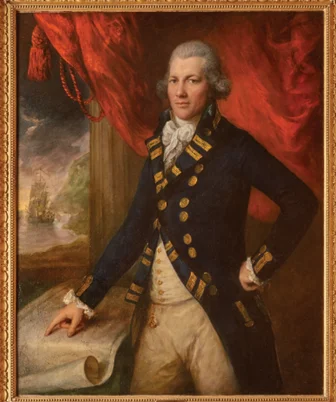A Picture of Captain Henry Roberts


Of all the many and varied portraits that hang on the walls of Floors Castle, there are few subjects that had a life as full of excitement and adventure as that of Henry Roberts (1757-1796).
Born in Shoreham, Sussex, the eldest of five children, Roberts first appears to the historical record as a 14 year old servant to the Captain of the yacht, Mary, in 1771.
He sailed on James Cook’s second voyage (1772-75) as an Able Seaman, then Master’s Mate and Midshipman aboard HMS Resolution. The voyage was on behalf of the Royal Society, in search of the Great Southern Continent, or Terra Australis. Cook and his expedition charted parts of the Antarctic, before moving on to Tahiti, then back towards New Zealand, landing at the Friendly Islands, Easter Island, Norfolk Island, New Caledonia and Vanuatu. Roberts was also involved in Cook’s third expedition (1776-79), this time aboard HMS Discovery under the command of Charles Clerke. This expedition also visited Tahiti, before sailing northwards to the Hawaiian Islands, named the Sandwich Islands after acting First Lord of the Admiralty, the 4th Earl of Sandwich. They then went on to explore the west coast of North America and Alaska.
Roberts’ skill as an artist meant he was charged with the production of charts and coastal views, and he was tasked with preparing charts from both expeditions for official publication, between 1781-84. This irritated William Bligh (later to be notorious for the events aboard HMS Bounty and himself a skilled navigator and cartographer), who had been Master of Cook’s Resolution on the third expedition, and thought the job should have been his.
Promotion to Lieutenant followed for Roberts in 1780, and he saw service aboard a receiving ship based in Portsmouth named Dragon. His first independent command was aboard the cutter, Speedwell, charged with the disruption of the smuggling trade around the Isle of Wight. In 1785 The Times reported his success in intercepting and apprehending notorious smuggler Pye Happs. In late 1789, he was in line to command a newly refitted Discovery on another expedition to the Southern Seas. Similarly to Cook’s expeditions, this was backed by famed botanist Joseph Banks and The Royal Society, with the aim of obtaining samples to return to the Royal collections at Kew. This was a major expedition to, bringing with it promotion to Commander, and had the secondary objective of searching for the remaining mutineers of the Bounty, still at large in the vastness of the Southern Ocean following the infamous incident of 1789. The expedition was postponed due to diplomatic issues with the Spanish, who were also interested in the control and exploitation of Nookta Sound, a deep water anchorage on the West coast of what is now Vancouver Island. The area was of particular significance to the fur trade and the access it provided to the lucrative Chinese market. The proposed South Seas voyage was eventually led by George Vancouver, who had served with Roberts as a Midshipman aboard Resolution on Cook’s second voyage.
In 1794 Roberts was finally posted Captain, in command of 40-gun Frigate Undaunted, and dispatched to the West Indies, where he took part in several successful actions, notably against Dutch West India Company assets, taking Demerara and Essequibo in April 1796, and Berbice (all in modern Guyana) in the following month. Shortly afterwards, Roberts succumbed to the same fate as so many serving soldiers, sailors and colonists in the region, contracted yellow fever and died. His old shipmate George Vancouver named Point Roberts, south of modern Vancouver (though a land exclave of the USA) in his honour. This portrait, attributed to Thomas Gainsborough was purchased by Ogden Goelet, and inherited by the 8th Duchess of Roxburghe. Roberts has no family connection to either the Goelets or the Dukes of Roxburghe, but this beautiful portrait is emblematic of an age when the Royal Navy was in its pomp and Britain was a hotbed of innovation, exploration and discovery. It currently hangs in the Ball Room at Floors Castle.

